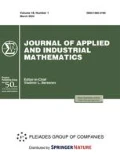Abstract
The well-known lower bound for the maximum number of prime implicants of a Boolean function (the length of the reduced DNF) differs by \(\Theta (\sqrt {n}) \) times from the upper bound and is asymptotically attained at a symmetric belt function with belt width \(n/3 \). To study the properties of connected Boolean functions with many prime implicants, we introduce the notion of a locally extremal function in a certain neighborhood in terms of the number of prime implicants. Some estimates are obtained for the change in the number of prime implicants as the values of the belt function range over a \(d \)-neighborhood. We prove that the belt function for which the belt width and the number of the lower layer of unit vertices are asymptotically equal to \(n/3 \) is locally extremal in some neighborhood for \(d \le \Theta (n) \) and not locally extremal if \(d \ge 2^{\Theta (n)} \). A similar statement is true for the functions that have prime implicants of different ranks. The local extremality property is preserved after applying some transformation to the Boolean function that preserves the distance between the vertices of the unit cube.
Similar content being viewed by others
REFERENCES
Yu. L. Vasil’ev and V. V. Glagolev, “Metric Properties of Disjunctive Normal Forms,” Discrete Mathematics and Mathematical Problems of Cybernetics, Vol. 1 (Nauka, Moscow, 1974), pp. 99–148.
A. A. Sapozhenko and I. P. Chukhrov, “Boolean Function Minimization in the Class of Disjunctive Normal Forms,” Itogi Nauki Tekh. Ser. Teor. Veroyatnost., Mat. Statist., Teor. Kibern. 25, 68–116 (1987) [J. Sov. Math. 46 (4), 2021–2052 (1989)].
M. M. Gadzhiev, “Maximum Length of Abbreviated DNF for Boolean Functions of Five and Six Variables,” in Discrete Analysis, Vol. 18 (Inst. Mat., Novosibirsk, 1971), pp. 3–24.
A. P. Vikulin, “Estimation of the Number of Conjunctions in the Abbreviated DNF,” Problemy Kibernet. No. 29, 151–166 (1974).
A. K. Chandra and G. Markovsky, “On the Number of Prime Implicants,” Discrete Math. 24, 7–11 (1978).
A. E. Andreev, “On the Problem of Minimizing Disjunctive Normal Forms,” Dokl. Akad. Nauk SSSR 274 (2), 265–269 (1984) [Sov. Math. Dokl. 29, 32–36 (1984)].
N. Kettle, A. King and T. Strzemecki, “Widening ROBDDs with Prime Implicants,” in Tools and Algorithms for the Construction and Analysis of Systems. Proceedings of 12th International Conference TACAS-2006 (Vienna, Austria, March 25–April 2, 2006) (Springer, Heidelberg, 2006), pp. 105–119 [Lecture Notes in Computer Science, Vol. 3920].
R. H. Sloan, B. Szörenyi, and G. Turan, “On \(k \)-Term DNF with the Largest Number of Prime Implicants,” SIAM J. Discrete Math. 21 (4), 987–998 (2008).
N. Talebanfard, “On the Structure and the Number of Prime Implicants of \(2 \)-CNFs,” Discrete Appl. Math. 200, 1–4 (2016).
G. P. Gavrilov and A. A. Sapozhenko, Tasks and Exercises in Discrete Mathematics (Fizmatlit, Moscow, 2005) [in Russian].
Author information
Authors and Affiliations
Corresponding author
Additional information
Translated by Ya.A. Kopylov
Rights and permissions
About this article
Cite this article
Chukhrov, I.P. Connected Boolean Functions with a Locally Extremal Number of Prime Implicants. J. Appl. Ind. Math. 15, 17–38 (2021). https://doi.org/10.1134/S1990478921010038
Received:
Revised:
Accepted:
Published:
Issue Date:
DOI: https://doi.org/10.1134/S1990478921010038


